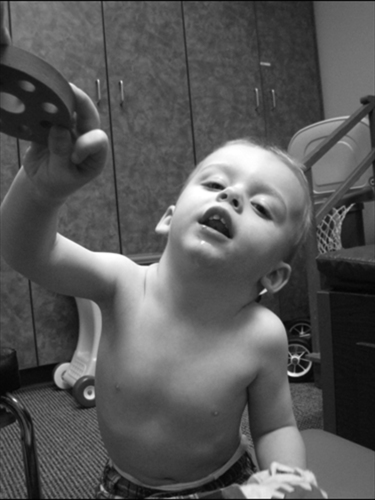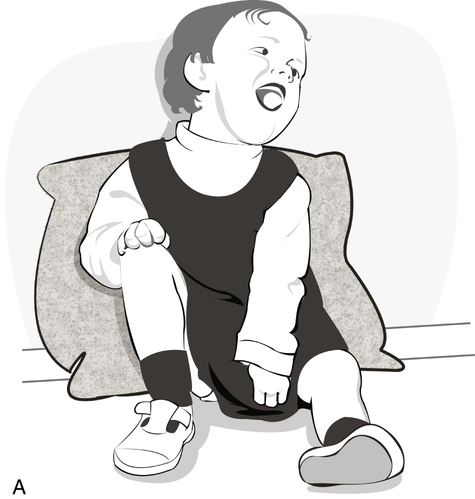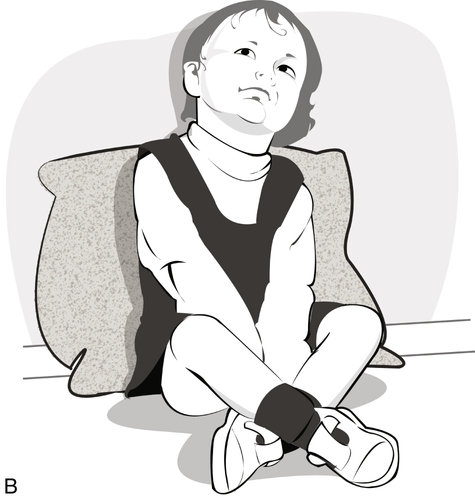16 PATTY COKER-BOLT, TERESSA GARCIA-REIDY and ERIN NABER After studying this chapter, the reader will be able to accomplish the following: • Describe the frequency, pattern, types, and classification of cerebral palsy (CP) • Identify the impaired progression of movement associated with CP • Describe the components of normal postural control and movement in children who have CP • Recognize the differences among motor development, motor learning, and motor control • Explain ways in which normal muscle tone and impaired muscle tone influence movement • Identify the role of the certified occupational therapy assistant in the assessment and intervention of movement disorders in children who have CP • Describe the range of interventions used with children who have CP, including medical, constraint-induced movement, complementary and alternative medicine, and splinting and casting Cerebral palsy (CP) is a term used to describe a range of developmental motor disorders arising from a nonprogressive lesion or disorder of the brain (Box 16-1).3 Associated brain damage is characterized by paralysis, spasticity, or abnormal control of movement or posture. While the injury to the brain is considered static, the pattern of motor impairment may change over time, affecting development in all daily occupations of childhood. The motor disorders associated with CP are often accompanied by disturbances of sensation, cognition, communication, perception, and/or a seizure disorder.12 The lesion or damage in the brain may cause impairment in muscle activity in all or part of the body. CP typically affects the development of sensory, perceptual, and motor areas of the central nervous system (CNS). This can cause the child to have difficulty integrating all of the information that the brain needs to correctly plan and direct the skilled, efficient movements in the trunk and extremities that are used in everyday interactions with the environment. The muscles shorten and lengthen in uncoordinated, inefficient ways and are unable to work together to create smooth, effective motion. Children who have CP demonstrate difficulty in achieving and maintaining normal posture while lying down, sitting, and standing because of impaired patterns of muscle activation.3,19 These abnormal patterns result from the decreased ability of the CNS to control coactivation and reciprocal innervation of select muscle groups. Coactivation of muscle is the result of a co-contraction of agonist and antagonist muscle groups around a joint. Simultaneous contraction of agonist and antagonist muscle groups provide stability around a joint and also affect overall body posture. Reciprocal innervations in muscle groups occur when excitatory input directs the agonist muscle to contract while inhibitory input directs the antagonist muscle to remain inactive.12,19 These reciprocal innervations allow for movement to occur around a joint and in the body. Children who have CP may develop abnormal movement compensations and body postures as they try to overcome these motor deficits to function within their environments. Over time, movement compensations and atypical motor patterns create barriers to ongoing motor skill development. Instead of freely moving and exploring the world, as children with a normally developing sensorimotor system do, children who have CP may rely on early automatic reflex movement patterns as their primary means of mobility. These early automatic reflexive movements occur without conscious control of the child and are typically elicited by a specific sensory motor action. Children with CP manifest primary impairments that are the direct result of the lesion in the CNS. Primary impairments are an immediate and direct result of the cortical lesion in the brain. The nervous system damage that causes CP can occur before or during birth or before a child’s second year, the time when myelination of the child’s sensory and motor tracts and CNS structures rapidly occurs. CP is described as nonprogressive, nonhereditary, and noncontagious.12 As a nonprogressive condition, the original defect or lesion occurring in the CNS typically does not worsen or change over time. However, because the lesion occurs in immature brain structures, the progression of the child’s motor development may appear to change. Normal nervous system maturation shifts control of voluntary movement to increasingly higher and more complex areas of the brain. The child who has CP exhibits some changes in movement ability that results from the expected progression of motor development skills, but these changes tend to be delayed relative to age and often show much less variety than those seen on the normally developing child. Children with CP develop secondary impairments in systems or organs over time due to the effects of one or more of the primary impairments.3,20 These secondary impairments may become just as debilitating as the primary impairments. For example, a child with CP may have a primary impairment such as hypertonia and a muscle imbalance across a joint. This abnormal muscle tone may cause poor alignment across a joint, further muscle weakness, and eventually a contracture in the joint. The resulting muscle contractures, poor body alignment, and poor ability to initiate movement would be considered secondary impairments. It is important to understand this, since the diagnosis of CP means that a child has a static nonprogressive lesion in the brain. Although the initial brain injury remains unchanged, the results or the secondary impairments are not static and change over time with body growth and attempts to move against gravity. Children with CP may continue to rely on automatic movement patterns because they are unable to direct their muscles to move successfully in more typical motor patterns (Figure 16-1). The atypical patterns used to play or complete functional activities may become repetitive and fixed. The repetition of the atypical movement patterns prevent children with CP from gaining independent voluntary control of their own movements and can lead to diminished strength and musculoskeletal problems. The combination of impaired muscle coactivation and the use of reflexively controlled postures may lead to future contractures in muscles, tendons, and ligamentous tissues, causing the tissues to become permanently shortened. Bone deformities and alterations of typical posture or spinal and joint alignment may also occur. CP is the leading cause of childhood disability, and the reported incidence varies from 2 to 3 per 1000 live births.12 The prevalence rate of CP has remained stable since the 1950s, in spite of dramatic improvements in prenatal and perinatal care over the last four decades.20 According to the United Cerebral Palsy (UCP) Foundation, there are nearly 800,000 children and adults in the United States living with one or more symptoms of cerebral palsy.21 The accident that causes brain injury may occur during the prenatal, perinatal, or postnatal period, but evidence suggests that 70% to 80% of the causes of brain injury are prenatal in origin (Box 16-2).3 Prenatal maternal infection and multiple pregnancies have also been associated with cerebral palsy.12 Other prenatal factors include genetic abnormalities and maternal health factors such as stress, malnutrition, exposure to damaging drugs, and pregnancy-induced hypertension. Some gestational conditions of the mother, such as diabetes, may cause perinatal risks to the developing fetus; prematurity and low birth weight significantly increase an infant’s risk of developing cerebral palsy.19 Medical problems associated with premature birth may directly or indirectly damage the developing sensorimotor areas of the CNS. In particular, respiratory disorders can cause the premature newborn to experience anoxia, which deprives cells of oxygen that cells need to function and survive. Typical postnatal causes of CP could include conditions that result in significant damage to the developing CNS, such as malnutrition or hypoxic ischemia resulting from lack of oxygen to the brain. Hypoxic ischemic encephalopathy is defined as damage to cells in the CNS (brain and spinal cord) caused by inadequate oxygen. Other postnatal causes include infections and exposure to environmental toxins. • Developmental integration of early, primitive reflex patterns • Emergence of righting reactions, equilibrium reactions, and protective extension reactions • Intentional, voluntary movements against the forces of gravity • The ability to combine movement patterns in the performance of functional activities The qualities of contractility and elasticity are necessary for the muscle’s accurate response to changes in stimuli experienced during movement, an event referred to as coactivation. Muscle tone allows muscles to adapt readily to changing sensory stimuli during functional activities. Children with CP resulting from a lesion in the CNS experience disruption in postural control; disruptions in righting, equilibrium, protective reactions; and atypical muscle tone. Decreased muscle tone, which is defined as hypotonia, can make a child appear relaxed and even floppy. Increased muscle tone, which is defined as hypertonia, can make a child appear stiff or rigid. In some cases, a child may initially appear hypotonic, but the muscle tone may change to hypertonia after several months of life and the influence of movement against gravity. An occupational therapy assistant (OTA) must possess an understanding of the ways in which postural control and muscle tone can affect normal movement patterns and everyday occupations when planning therapeutic interventions for children with CP (Box 16 -3). This knowledge is imperative for planning functional therapeutic activities that are appropriate for the child’s age and physical abilities. Reflex–hierarchical models propose that purposeful movement is initiated only when the individual experiences a need to move.19 When the desire to move is stimulated, the person searches his or her long-term memory for a pattern of movement that will accomplish the desired task. The movement patterns that the person has practiced the most are the most likely to be used again because they are embedded in memory. The person prepares to execute the movement, incorporating additional information from the environment to make the movements meet the demands of the task. For example, when a child is thirsty or hungry and sees food or drink, the child will become motivated to reach for or move to the desired food or drink. Long-term memory is searched for a pattern of movement that will enable the child to achieve the desired goal, that is, to reach the food or drink. Because all previous efforts to reach a bottle were stored in a generalized movement program, the child has a general history of the motor skills necessary for proper sequence, timing, and force of motor actions. Environmental factors, such as the sizes and weights of the objects, are also considerations used to determine the appropriate movement patterns. Sensory feedback determines whether the child’s movement efforts have been successful (i.e., have met the task demands). The agonist muscles help lift the food or drink to the mouth, while the antagonist muscles are programmed to relax, allowing the movement of the agonist muscle to occur. Coactivation occurs when both the agonist and antagonist muscle groups work together to stabilize the container of the food or drink at the mouth in order to actually eat or drink. With continual repetition, these movement patterns can develop into motor skills. Reflex–hierarchical models support the idea that motor learning optimally occurs when a person engages in repeating the same task during frequent, regular practice; breaking down a task during frequent, regular practice into small parts is the most effective way to learn the entire task. The dynamic systems approach to understanding motor behavior proposes that postural control is greatly influenced by an individual’s many volitional and functional daily tasks and activities.19 Systems theorists recognize that it is impossible to understand motor control issues without understanding the external and internal forces that affect movement against the forces of gravity. Systems models purport that posture and movement must be flexible and adaptable so that a person can perform a wide range of daily activities, whereas reflex–hierarchical models state that the control of posture and movement is the outcome or product of a process. Dynamic systems models postulate that posture is anticipatory to the initiation of movement. Postural adjustments actually precede movements; they prepare the body to counterbalance the weight shifts that are caused by the movement activity. In this way, less balance disturbance occurs. Dynamic systems theorists also suggest that control of movement occurs due to the interactions of many body systems working cooperatively to achieve a desired movement goal. This concept is called the distributed model of motor control. Consider this example of a child trying to catch two balls, one of which is a small tennis ball and the other a large, heavy medicine ball. Before catching the balls, the child has used his or her vision to inspect them, used visual perception to make decisions about their sizes and weights, assumed an appropriate postural stance, and positioned the arms forward away from the body to be ready to catch. This anticipatory process is called feedforward.
Cerebral palsy
Progression of atypical movement patterns
Primary and secondary impairments
Frequency and causes
Posture, postural control, and movement
Muscle tone
Postural development and motor control
Reflex–hierarchical models
Dynamic system models
![]()
Stay updated, free articles. Join our Telegram channel

Full access? Get Clinical Tree


Cerebral palsy
Only gold members can continue reading. Log In or Register to continue



